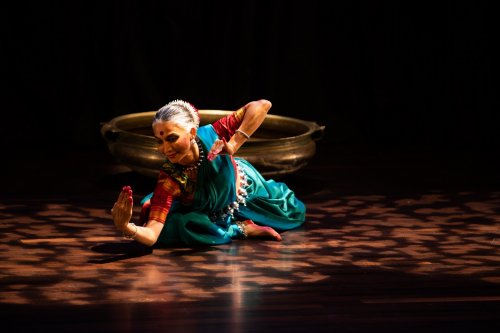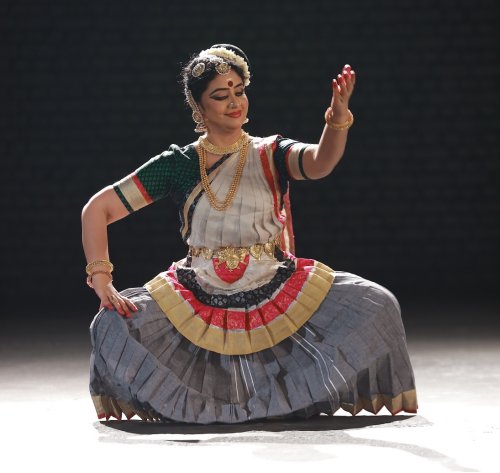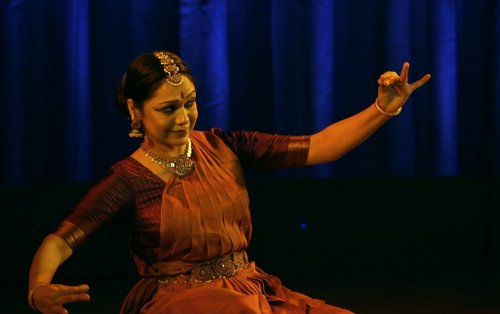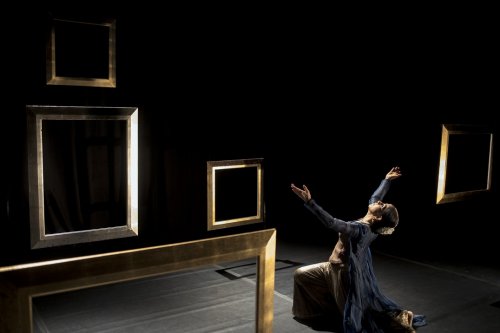
|   |

|   |
 e-mail: leelakaverivenkat@gmail.com Anvesana's Reflections in Solitude stir creative energies to fresh leaps of hope Photos courtesy: Sampradaya June 1, 2021 Like a ray of sunshine amidst darkness was Anvesana - Reflections in Solitude, brainchild of Lata Pada, organised by her dance centre Sampradaya Dance Creations of Toronto in Canada. This unique initiative, premiering a digital dance festival of commissions, featuring an excellent choice of four dancers pertaining to different Indian classical disciplines, in solo performances, revealed how the quiet of non- performance, aside from not draining the performer's physical energies, does not reflect aridity in art. Creativity needs solitude and quiet for deep reflection and for new ideas to sprout, throwing up unexplored terrain leading to new directions, while being rooted in the ethos of the dance form.  Bijayini Satpathy The prelude to the festival with Lata Pada's meaningful interaction with each of the dancers saw Odissi dancer Bijayini Satpathy, very attractive with the untouched grey strands in her hair, revealing how instead of getting disheartened by the pandemic, she had used 'this expanded moment of pause' to reflect on how to deal with what for her resembled a 'mid-life crisis'- when she had moved on after years as one of the star performers of the Nrityagram Ensemble to solo dancing , where in the place of teaching youngsters and conducting classes, she had to take up the challenge of being her own director, choreographing her own items , instead of being directed, performing choreographed compositions. In her programme 'Call of Dawn', she envisaged a whole Odissi solo presentation, based on just one raga, totally avoiding a feel of being repetitive - and the formulation of the music, was the first part of the venture. She picked on Ahir Bhairav, the early morning raga to suit her title, perhaps influenced by a Nazrul Islam song, round which she built her plot. Already set to Ahir Bhairav, the antara and mukhada for the piece, were composed by her brother, the well known flautist Srinibas Satpathy, who was also responsible for the music arrangement, with her other brother Shivshankar Satpathy providing the rhythmic inputs, while the nritta mainstay of Pallavi in Ahir Bhairav for this programme, and also the Chakravakam Pallavi which came as a short prelude, were composed by singer Sukanta Kundu with rhythmic arrangements contributed by Dhaneswar Swain, with both Bijayini and Budhanath Swain together working out the setting. The start with Oned sees a young maiden looking at the abstract Shivalinga symbolising the oneness of the male and the female - reflecting in her mind, images spurred by Ardhanariswar, with the male attributes of Shiva and of the female in Parvati, in contrasting opposites, complementing each other as one unseparated entity. Shankaracharya's sloka "Champeya Gauranga" comes as an obvious choice, not only for the images it reflects, but also because interred in the Odissi dance form itself, are the majesty of the chowk, along with the sensuous grace of the tribhanga providing an ideal body language for bringing out the male/female contrast. The score in Ahir Bhairav was composed by Bindumalini, whose melodious vocal support for the performance adds its own richness. Bijayini's presentation, whether visualising Shiva in his flowing locks with the Kapala Mala and snake round his neck, or Parvati's Dhammila hairdo, with the mandara mala gracing her neck, along with all the other contrasting attributes, is Odissi at its best. The young maiden watching a mendicant pass by wonders about the kind of husband she will have. The Nazrul song Ahirini, with the words "Hey Shibo Sundara" added by the dancer, has the young maiden addressing Shiva and expressing herself, turning down the all mighty God as life's mate, as being too over powering for her - settling instead for the allure of Krishna. The Pallavi comes as an 'abstract expression of the sweetness of anticipation' showing the Chakravakam birds as the symbol of yearning and love -separated in the morning to be reunited at night. With manjira played by Budhanath Swain, the Pallavi choreography is a delight, Bijayini's perfection in every microscopic moment of a movement, flowing naturally from unbroken years of a fitness regimen along with back-breaking practice. Talking of dance and art as anchors in life, she mentions how consistent hard work is the only way to perfection, for the seed within to grow and become a tree -As Odissi speaks and reveals itself more and more to you, ideas flow. One needs to listen to the body with the dance interred in it. Mahesh Bhat's cinematography, as also the delicate lighting by Sujay Saple, completes what is an absolutely engrossing performance.  Methil Devika Methil Devika in her interaction with Lata Pada frankly affirmed that for her the pandemic isolation, much like the women in our villages or Annapoorna Devi who retired into total solitude for years, was neither stifling nor energising. Not given to frequent performances, constantly being in public spaces was not important for her. Mohiniattam, the dance she excels in, was in any case not given the kind of exposure other dance forms attracted. Her work 'Ahalya' on one of the important Ramayana heroines, was based entirely on how Kavi Valmiki in the 48th and 49th cantos of the Bala- Kanda conceives of her. Following soothing strains on the veena, the dancer enters to a short prelude in pure dance rendered to rhythmic syllables, with the lights focussed on the moving body not articulating facial features. Prince Rama, eyeing what looked like a hermitage in the distance asked Sage Viswamitra ("Mithilopavane tatra ashramam drishya") why it was desolate (nirjanam) and without a Muni (Munivarjitam). And Vishwamitra narrates the story of the hermitage where the greatest of sages in the past, Gautama ("Gautamasya narashreshta poorvamaaseem mahatmanaha) with his beauteous wife 'Lokasaundarya Ahalya' (signature line by the dancer) performed austerities. Only now does the video footage focus light on Ahalya's face. A straight forward, non-judgemental narrative, Valmiki's Ahalya, visualises a very realistic picture of woman (without the accretions woven into this story by later writers, to paint a chaste blameless Ahalya deceived by Indra's disguise, and being cursed to become a stone etc). In Valmiki's story, as shown briefly by the dancer through expressions and mudras, Ahalya is living an austere life with her husband Sage Gautama, who does not entertain physical intimacy with the wife unless for the purposes of begetting a child. It is a peaceful hermitage with the flowers and birds, wherein Indra enters during Gautama's absence. Bewitched by the beauty of Ahalya, to the signature line (added by the dancer herself) "Indra atteendra…" the King of Gods, described as the One with 1000 eyes and spouse of Sachi, enters the hermitage, trying to convince Ahalya that one desiring sensual gratification does not wait for a propitious time. Though not fooled for a moment by his disguise as her husband (which she makes fun of for its total lack of conviction), Ahalya succumbs to Indra, gratifying her own sensual urges. Post the idyllic coming together, before Indra could escape from the hermitage, Gautama makes his appearance - with spiritual energies activated by a holy bath, carrying blades of Kusha grass and firewood for the sacrificial fire. He curses Ahalya that only after thousands of years of lying on ashes atoning for her sins, living only on air (vayubhaksham aahaaram), will she be redeemed to her old self in all her lustre, when Rama steps into the hermitage. Excellent in mukha bhavam, with treatment which is very telling in its simplicity, yet full of conviction, is Devika's expression as Ahalya ,conveying the horror of what is happening to her. Devika has a knack for lucidity amidst brevity and with just one emphatic gesture, she communicates the idea of Ahalya being rendered indiscernible, with all the three worlds closed, unable to perceive her. The music, again her own creation, with no musicians available for rehearsals during the pandemic, scenes communicate through the vocabulary of rhythmic syllables, and very powerful and imaginative use of the mizhavu, Kerala's most communicative percussion instrument, played by Kalamandalam Rahul, with the edakka by Sajith Pappan also used in places. Devika's narrative takes only a few important lines from Valmiki - though the portrayal of Ahalya's personality is completely as given by Valmiki in the 48th and 49th cantos of the Bala Kanda. The same woman who gives in to sensual gratification also has the resolve of overcoming desire by becoming deeply involved in her inner self - with penance and internal search for attaining self- realisation, enabling her to attain Ramatwam or oneness with Rama within her. Here Devika has used the bhav soaked lines from Ezhutachhan's Ahalya shlokam. The music with the veena by V.S. Sounderajan used very effectively in places, utilises very few ragas like Suddha Dhanyasi, Natakuranji, Kanakangi with the singing by Payyannur Mahendran, which carries the same quality of being persuasive with bhava - without being ornamental. While the dancer frankly says that she is not out to do anything daringly innovative or experimental, one admires the economy of treatment wherein less says more - rare among most dancers who fall for too much elaboration.  Rama Vaidyanathan For a prolific dancer like Rama Vaidyanathan, literally living on a performance treadmill for years, the pandemic has meant a year of real change, and notwithstanding all the dissolution, loss of motivation and living in a cocoon of webinars for the dance dialogue to go on, dance has provided her an anchor. In the interaction with Lata Pada, Rama expressed the feeling that the pandemic through virtual events, has perhaps taken dance even to people who would never enter an auditorium, to watch a performance. Sampradaya's initiative Anvesana: Reflections in Solitude, set Rama thinking on the 'concept of unlearning' leading her to dialogue with the confirmed boundaries of her dance, in what has been an imperative process. With the years bringing in inevitable changes in bodily agility, the dancer, she realises, is constantly negotiating boundaries and like the kite soaring in the sky, changing directions while held on a string, her dance while constantly adjusting to the body's physical capacities, is grounded in her Bharatanatyam dance 'taiyari' . So, while she is in tune with dance unconnected with religion, she loves the 'margam' too. With mastery over years, both deconstruction and reconstruction are possible, and one realises that the borders are not inhibiting but liberating factors, and dance gives her the anchor, keeping her strongly anchored. And this is the point she elaborates through a line from Tirumoolar's Turumandiram used as a punchline in her work "Adanggada ennai adakki adi vaittida.." (keeping grounded even one who is uncontrollable). In her recital "Moving Boundaries" Rama proves that within the Margam lies a whole world to explore for a dancer. And what a singer she has in Sudha Raghuraman! Always very creative, the endless possibilities Rama's movements spin within a 'Taiya thai', 'Tat thai ta ha. Dhitthaitha ha' are mind boggling. Hands moving at varying speeds, with feet grounded or off the floor, performing a whole game of playing with the ball to a "Kitataka tarikita tom" it is as if rhythm has refrain even in the tanpura drone, creating its own vibrations and music - all radiating the joy of movement. "Anandam, Adarangam, Anandam" - With Sudha's music, minimal in sahitya largely improvised, crooning a raga, or delighting in electric solfa passages, or in taanam variations , both music and dance in joyous, unbounded free styling liberty, like the bird in the sky, the peacock on the ground, the moving skies and the galloping waves, add up to this entire Universe being in a never ending dance of joy and creation (Anandan akhikasaracharam) much like the dance of Nataraja, but all spelling a cycle "Bootanda, Petaanda, Yogaanda, Bhogaanda" goes Sudha's equally creative music with its soaring improvisations, while grounded in the classical Carnatic music idiom, echoing the joy and abundance of liberty, while rooted in the classical tenets. The section with Sudha singing in Mayamalawagowla, with musical interventions on instruments like the morsing, are hair raising! In what is an exhilarating performance, it all comes back to the line "Adangaada ennai adakki adi vaittida".  Aditi Mangaldas Kathak exponent Aditi Mangaldas, whose production "Naav mein Nadiya" was the finale for Anvesana, in a very thought provoking interaction with Lata Pada laid bare her sense of emptiness resulting from the pandemic. To use a simile, it was like being lost in the Forest, when the river of our life is dammed, or has changed its course, with "emotion on a roller coaster" - and one does not know if it is the boat in the river or the river in the boat. It seems that performing what one normally did for years in dance, is irrelevant at a time when life's narratives have been stolen and one is left with just the empty frames of memories hanging. When even the mirror on the wall reflects a face one no longer recognises, how does dance give vent to the surreal sense of time and space one is living in? How does one motivate oneself at a time like this? Aditi has slowly found during the process, how technology could be used as an enabling factor. The whole area of dramaturgy and learning to work with the camera imaging the dance has been a whole new experience. The greatest aspect about this production which Aditi revealed was how, with the pandemic cutting out assembling the entire crew with musicians for any kind of rehearsal, right from the starting point of discussions to conceptualising, getting music score worked out, and choreography - each component of the production was virtually carried out , without the team physically coming together - the entirety, when assembled, providing a whole new exploration. Aditi is sharing the experience with young dancers to enable their discovering creativity within each one. What becomes a process of going from Self to Selflessness, had to be applied to other areas of life too - leading to realising the need for togetherness, to instil in every artist the confidence to reach out. Aditi also, has tried in her way to help lessen the problem of finding financial security for the artists during times like now, lacking in our country today. While pondering on the what and the how of the performance, singer Shubha Mudgal brought to her notice a poem of Kunwar Narain "Naav mein Nadiya" (River in the Boat). Her student Gauri Diwakar drew her attention to a poem by Bhartendu Harishchandra "Chhann Chhann Chhip Chhip" (now seen , now not) wherein a deer as protagonist, seeing the moon in the sky and its reflection in water, is quite confused about what is real and what unreal. Is illusion real? To an elegantly designed very symbolic setting, the opening scene of "Lost... in the Forest," has dancer Aditi spinning 'chakkars' , wending her way, amidst an entire performance space full of empty frames. Finding her way around, in between, in front of or at the rear of these frames, the frames as props represent the forest, the shores of a river, the bordering for the waters of a still river or turbulent waters - even signposts of time and space - in fact, the whole of life. "Nadi hai andhera .." Dark are the waters and what lies on the other side. Are the shores near or far away? Is the boat in the river or the river in the boat? Standing behind a frame looking in, wondering whether the other side is dark or bright, the dancer's eloquent hands convincingly express the feeling of being lost - stretching out through the frames in desperation trying to reach out, or encircling it from both sides, the hands failing to meet in the centre . 'Kaun kismet duba hai?' Who is drowned, in what? Some of the camera effects of an empty frame swinging in the breeze and the moon in the sky reflected in the waters, are very poetic. The entire choreography features all the elements of Kathak nritta rendered to the Nagma, without restricting the flow of the plot. The evocative abhinaya in the next scene to Bhartendu's poem "Chhann Chhann Chhip Chhip" has the intimacy of sringar, with lovers amidst the moon, and the ghungat (Dekh Sakhi Chanda...Ghungat) and the coupling animals, rendered to Faraz Ahmed's singing. Tempo gradually increases and excellent footwork is always Aditi's forte. But never does virtuosity interfere with the flow and feel of the dance narrative. And finally, out of this lost in the woods feeling, comes the deer leaping to a hopeful future. After all tomorrow is another day - and as said, "Hope rises eternal in man's breast for Man never is but always to be blest." A gripping performance indeed! Altogether a scintillating presentation by the dancers and Anvesana may well be proud of this support given to creativity, crying out in the silence for expression.  Writing on the dance scene for the last forty years, Leela Venkataraman's incisive comments on performances of all dance forms, participation in dance discussions both in India and abroad, and as a regular contributor to Hindu Friday Review, journals like Sruti and Nartanam, makes her voice respected for its balanced critiquing. She is the author of several books like Indian Classical dance: Tradition in Transition, Classical Dance in India and Indian Classical dance: The Renaissance and Beyond. Comments * What a wonderful review. Made me so curious to see the work! - Patrick Suzeau (March 8, 2022) * Reading it, I was transformed to the place as an audience, witnessing dance performances as I go on reading word by word. That's the power of writing of Leela Venkataraman ji. In 1980s, I used to read her articles in The Hindu and few other papers. As I read Shanta Serbjit ji. Both I consider as Guru since their writing kindled love for dance. I learnt from Guru Prerna Shrimali ji at Gandharv Mahavidyalaya, Delhi, too. Last I saw and heard Leela ji at IHC Centre, I think in 2012-13. Nice reading. - Katyayan Kanyakubj Gaurang Brahmavarti Mishra Post your comments Pl provide your name and email id along with your comment. All appropriate comments posted with name and email id in the blog will also be featured in the site. |